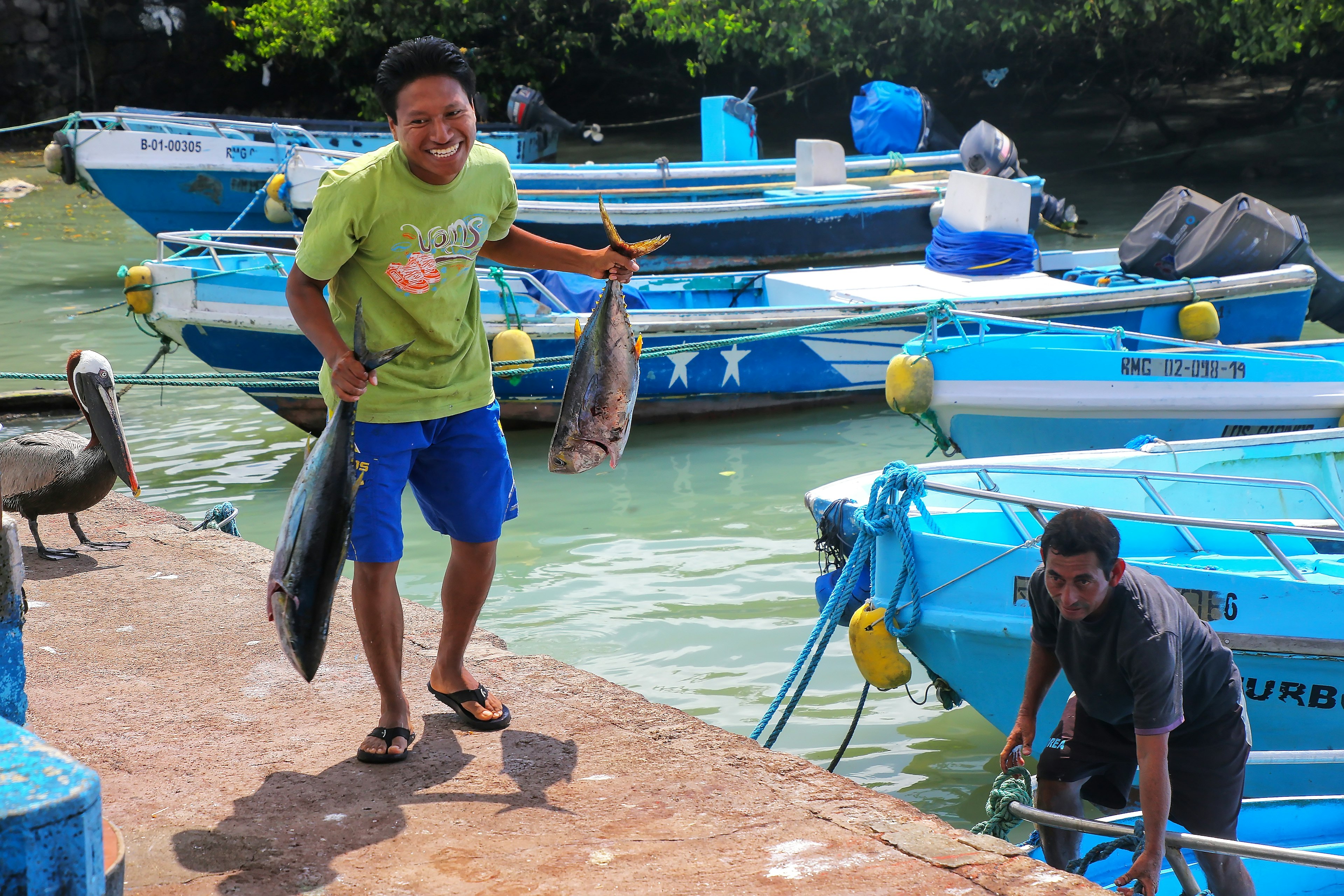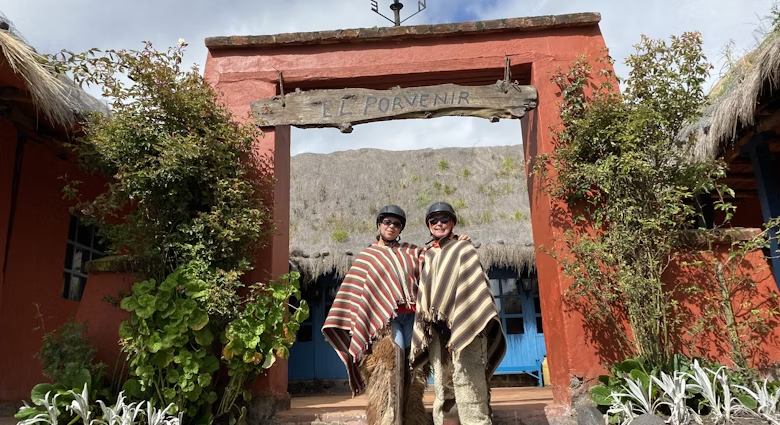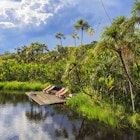
Everything you need to know about visiting the Galápagos Islands

Nov 10, 2024 • 9 min read

Hop onboard a private speed boat to San Cristóbal and see a marine iguana on Cerro Brujo beach © Shutterstock
Good news for everyone hoping to book the ultimate Galápagos Islands trip. You don’t need to book a cruise to discover the wonders of this destination. There are a number of different options for visiting the Galápagos. Regis St Louis, who has journeyed extensively across the archipelago for multiple editions of Lonely Planet Ecuador, explains how to visit the Galápagos Islands, create an independent itinerary, and even save some money while doing it.
Question: I’ve been dreaming about taking a trip to the Galápagos archipelago, but it seems like the only way to visit is on an all-inclusive cruise. Are there any other ways to visit the islands?
Regis St Louis: The majority of visitors to the Galápagos travel around the islands on a cruise, which costs somewhere between US$400 and US$1000 per person per day. However, there is a far more economical way to explore different facets of the archipelago. By traveling independently, using inter-island boats and basing yourself at onshore hotels and guesthouses, you can easily cut your costs significantly, to $200 a day or less.
What to know about the fees and etiquette
Government Fees for visitors
In August 2024, the Ecuadorian government raised the Galápagos visitor fee to US$200 per person for most international visitors (including US nationals) and to $100 per person for visitors from the MERCOSUR countries of Argentina, Brazil, Colombia, Paraguay, Peru, and Uruguay. This visitor fee is mandatory and goes toward protecting Galápagos National Park from the dangers of overtourism. You will also need to pay US$20 for a transit card before you board your flight to the island.
Etiquette
When you visit, it’s important to follow some rules to respect and protect nature in the Galápagos. Littering, for starters, is a big no. It’s also important to maintain a respectful distance of six feet (or 2m) from wild animals, and to avoid feeding them. Stay on the designated trails, and avoid flash photography. That said, you also want to focus on supporting businesses that go the distance to protect their local environment. Finally, don’t buy products made from sensitive natural materials like black coral, marine tortoise shells, or sea lion teeth.
When to go
Wet vs. dry season
When you visit the Galapágos depends on what you want to do, what weather you prefer, and which animals you want to see.
The weather defines the islands’ dry and wet seasons. Calmer ocean conditions coincide with warmer, wetter weather from December to May, when water temperatures average a super pleasant 24°C. Though waters are rougher and temps cooler from June to December, wildlife is more abundant. Shoulder season from August to October tends to see fewer crowds.
If you’re hoping to spot animals like hammerhead sharks, manta rays, marine iguanas, sea turtles, penguins, and sea lions, you probably want to go during the warm and wet season. But if you’re aiming to see whales and dolphins, whale sharks, giant tortoises, and a wider variety of birds (including the famed blue-footed boobies), you probably want to go during the cool and dry season. If you’re hoping to do some diving or snorkeling to view more of the native marine wildlife, you’ll probably want to go during the warm and wet season. But if you prefer exploring more on dry land, you may prefer the hiking conditions during the cool and dry season.
El Niño and La Niña
Another thing to remember while planning a Galápagos trip is the global climate phenomena known as El Niño and La Niña. During El Niño years, warm ocean currents and storm systems drift north to North America’s Pacific Coast during the winter months, and the sudden loss of trade winds and nutrient-rich cool water can harm local Galápagos wildlife like penguins, seals, and iguanas. Whereas during La Niña years, cold ocean currents keep winters extra dry for much of North America’s west coast, and the abundance of nutrient-rich cool water in the Galápagos tends to benefit local wildlife.
How to reach the Galápagos Islands
The Galápagos Islands lie 1000km west of mainland Ecuador. If you’re not setting sail on a cruise, getting there means taking a flight from Quito or Guayaquil. Most flights depart in the morning, so if you are flying from your home country, your Galápagos flight will likely depart the day after you arrive in Ecuador.
Flights serve both Santa Cruz Island (Baltra airport; GPS) and San Cristóbal Island (SCY). If you have more than a few days to spend on the archipelago, it’s easy to fly into one island and back to the mainland from the other.
Before checking in to your Galápagos flight at Quito or Guayaquil, you will need to pay a US$20 fee for a mandatory tourist transit card and have all your luggage inspected by the Galápagos Biosecurity Agency. Once you arrive at Baltra or San Cristóbal, you must pay the above-mentioned US$200 Galápagos National Park visitor fee in cash. Keep in mind that non-residents are not allowed to purchase one-way tickets to the Galápagos. You will also probably need to plan an overnight stay in Quito or Guayaquil before catching your flight home.

Inter-island travel in the Galápagos
There are quite a few misconceptions about this famous archipelago. Some people imagine a wilderness full of exotic plant and animal life scattered across rugged, entirely uninhabited islands. Plenty of unique species exist here, from massive tortoises to ocean-going lizards. Meanwhile, the terrain resembles few other places on Earth with its otherworldly lava tunnels, misty highland forests and pink-sand lagoons.
Some 32,000 people are scattered across four main islands in this remote corner of Ecuador, while the fifth island of Baltra just has an airport. When residents move between the islands, they don’t travel by cruise ship.
Private speed boats (called lanchas) offer an affordable way to hop between these main islands. Isla Santa Cruz is the hub, with daily departures west to the island of Isabela, east to San Cristóbal and south to Floreana. These boats leave in the morning and afternoon and take around two hours each way. The current one-way fare is around $35 (Ecuador uses the US dollar, making for easy, conversion-less travel for American visitors).

Using these small, fast boats to get around, you can base yourself at the main town on each inhabited island, then take day trips to see many of the natural wonders of the Galápagos.
You can splash out for a few day tours (or skip them altogether), then supplement your island experience with DIY adventures. Puerto Ayora, the archipelago’s largest town, is home to the Charles Darwin Research Station, which offers fascinating insights into an important breeding program for giant tortoises. (This tortoise tour only costs $10.) North of town, at El Chato Tortoise Reserve, you can see the lumbering giants in the wild. At nearby Los Gemelos, vermilion flycatchers flit through the air amid rare scalesia forest. Over on Isla San Cristóbal, you can hire a bike for a spin out to La Lobería, where marine iguanas bask in great piles on the rocky beach. Isabela, the biggest island, makes a great base for memorable adventures, including a full-day trip up to Sierra Negra, with its simmering fumaroles and otherworldly views across a volcanic landscape. A short boat ride from Puerto Villamil (Isabela’s principal town), Las Tintoreras is one of the archipelago’s best places for snorkeling in the midst of Galápagos penguins.

The pros and cons of DIY Galápagos travel
It’s important to keep in mind that many places in the Galápagos are simply not accessible by day trip. If you’re dying to see the waved albatross, for instance, you’ll need to go to Isla Española, the only place in the archipelago where you’ll find a huge colony of the birds (from April to December). Yet you can’t get there unless you’re traveling on a live-aboard boat that includes the island in its itinerary (not all cruises do). Likewise, Isla Genovesa, Isla Marchena and Isla Wolf (famous for its scuba diving) are all too remote to reach on a day trip.
On the other hand, traveling exclusively by cruise ship gives you only the briefest of glimpses of another fascinating side of life: the islands’ human dimension. Puerto Ayora’s seaside market features fishmongers dexterously preparing the day’s catch under the watchful gaze of sea lions and pelicans. While in town, you can try restaurants like Isla Grill, Almar and Garrapata to taste local flavors and enjoy authentic Ecuadorian cuisine. A short boat ride followed by an easy hike takes you to Las Grietas, which draws locals and the odd tourist for a swim through sun-dappled waters while daredevils launch themselves from the overhanging cliffs. At Playa Mann, there’s the curious spectacle of families relaxing on the sands besides basking sea lions. And with no ship-based itinerary to follow, you won’t have to miss out on beautiful beaches like Tortuga Bay, reachable via a forest-lined path from town. Staying onshore also gives you ample opportunities to hear stories from locals – people like Elena Albarado, a resident of the Galápagos since 1983, and owner of the eco-friendly Casa del Lago.
Speaking of lodging, you’ll find plenty of options, both budget-friendly and more luxurious, on all of the inhabited islands. Higher-end places, like Pikaia Lodge and Galapagos Safari Camp, also offer land-based tour packages. And if you’re interested in pick-and-mix tours, local operators offer a full gamut of half- and full-day excursions like those offered by Galapagos BK Tours, with departures from Santa Cruz, Isabela and San Cristóbal.
More ideas for saving money on your Galápagos trip
As we discuss how to visit the Galápagos Islands, you might still be wondering when to book your trip to score the best deals. As mentioned earlier, the Galápagos has no official high or low season. That said, October usually marks the tail end of the islands’ cool and dry season, so this might be your best time to find lower prices and fewer crowds.
While you can score some last-minute deals on flights, accommodations, tours, and cruises, this is always risky. Again, it’s important to remember how popular the Galápagos is with tourists year-round. You’re almost always better off booking everything as far in advance as possible to avoid those last-minute markups that tend to occur much more frequently than last-minute sales.
Technically, there are hardly any free attractions since you have to pay for your tourist transit card and for entry into Galápagos National Park. Nonetheless, you can find places like the Charles Darwin Research Station with many free activities, such as offering free access to the beautiful La Ratonera and Station beaches. Even better, the Galápagos has plenty more beaches that don’t cost any extra money, such as Playa Mann and Punta Carola on San Cristóbal Island and Tortuga Bay and Playa el Bazan on Santa Cruz Island. And if you come with your own equipment, you can enjoy epic surf sessions at many of these beaches. (Even if you don’t, you can find affordable surfboard rentals at local shops.)
For most wilderness areas, you need to pay for a guided tour. However, a few trails, such as the one to Playa Baquerizo on Isla San Cristóbal and the hike to Media Luna and Cerro Crocker on Isla Santa Cruz, are free to access. And if you’re more of an urban explorer, you can have some fun wandering around town at Puerto Ayora (on Isla Santa Cruz) and Puerto Baquerizo Moreno (on Isla San Cristóbal).
Explore related stories

Activities
Copy My Trip: Exploring Ecuador and the Galápagos with ElsewhereNov 25, 2024 • 5 min read








 Water SportsWhy Belize is better for scuba diving than the Great Barrier Reef
Water SportsWhy Belize is better for scuba diving than the Great Barrier ReefMay 21, 2024 • 5 min read
